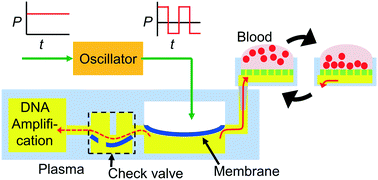Pulsatile plasma filtration and cell-free DNA amplification using a water-head-driven point-of-care testing chip†
Abstract
We demonstrate a microfiltration chip that separates blood plasma by using water-head-driven pulsatile pressures rather than any external equipment and use it for on-chip amplification of nucleic acids. The chip generates pulsatile pressures to significantly reduce filter clogging without hemolysis, and consists of an oscillator, a plasma-extraction pump, and filter units. The oscillator autonomously converts constant water-head pressure to pulsatile pressure, and the pump uses the pulsatile pressure to extract plasma through the filter. Because the pulsatile pressure can periodically clear blood cells from the filter surface, filter clogging can be effectively reduced. In this way, we achieve plasma extraction with 100% purity and 90% plasma recovery at 15% hematocrit. During a 10 min period, the volume of plasma extracted was 43 μL out of a 243 μL extraction volume at 15% hematocrit. We also studied the influence of the pore size and diameter of the filter, blood loading volume, oscillation period, and hematocrit level on the filtration performance. To demonstrate the utility of our chip for point-of-care testing (POCT) applications, we successfully implemented on-chip amplification of a nucleic acid (miDNA21) in plasma filtered from blood. We expect our chip to be useful not only for POCT applications but also for other bench-top analysis tools using blood plasma.



 Please wait while we load your content...
Please wait while we load your content...